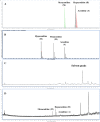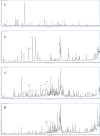A comparative study on the traditional Indian Shodhana and Chinese processing methods for aconite roots by characterization and determination of the major components
- PMID: 24156713
- PMCID: PMC4015782
- DOI: 10.1186/1752-153X-7-169
A comparative study on the traditional Indian Shodhana and Chinese processing methods for aconite roots by characterization and determination of the major components
Abstract
Background: Aconitum is an indispensable entity of the traditional medicine therapy in Ayurveda and Traditional Chinese medicine (TCM), in spite of its known fatal toxicity characteristics. The prolonged use of this drug, irrespective of its known lethal effects, is governed by the practice of effective detoxification processes that have been used for decades. However, the processing methods of Ayurveda and TCM are different, and no comparative study has been carried out to evaluate their differences.The objective of the present study was to carry out comparative chemical profiling of the roots of Aconitum heterophyllum Wall, A. carmichaelii Debx., and A. kusnezoffii Reichb. after application of two detoxification methods used in Ayurveda and one method used in TCM .
Results: Analysis of the processed samples was carried out by ultra-high performance liquid chromatography combined with quadrupole time-of-flight mass spectrometry (UHPLC-QTOF/MS). The results obtained in the study demonstrate that all three processing methods used in Ayurveda and TCM effectively extract the diester diterpenoid alkaloids and led to their conversion into monoester diterpenoid alkaloids. The efficiency of the processes in reduction of toxic alkaloid contents can be stated as: Processing with water > Shodhana with cow milk > Shodhana with cow urine. The analysis method was validated as per ICH-Q2R1 guidelines and all the parameters were found to comply with the recommendations stated in the guidelines.
Conclusions: There have been no reports till date, to compare the processing methods used in Ayurveda with the methods used in TCM for detoxification of aconite roots. Our study demonstrates that, these methods used in both the traditional systems of medicine, efficiently detoxify the aconite roots. Amongst the three selected procedures, the TCM method of decoction with water is the most efficient. Through experimental evidences, we prove the conversion of toxic diester diterpenoid alkaloids to relatively safer monoester diterpenoid alkaloids. Thus, this study demonstrates that comparative study on the traditional experiences accumulated in different medical systems is useful for expanding their respective applications.
Figures






References
-
- Mishra SN. Rasendra chintamani. India: Chaukhamba Orientalia; 2000.
-
- Heiner F. The flagship remedy of Chinese medicine: reflections on the toxicity and safety of aconite. Am J Chin Med. 2012;7:36–41.
-
- Liangqian L, Kadota Y. In: Flora of china. Wu ZY, Raven PH, editor. Missouri Botanical Garden, Beijing/St. Louis: Science Press; 2001. Aconitum L; p. 149.
-
- Anonymous. Wealth of India: Raw materials. New Delhi: CSIR; 1979.
-
- Ministry of Health and Family Welfare. The ayurvedic formulary of India. New Delhi: The Controller of Publication; 1977.
LinkOut - more resources
Full Text Sources
Other Literature Sources

